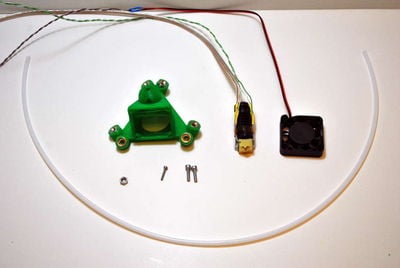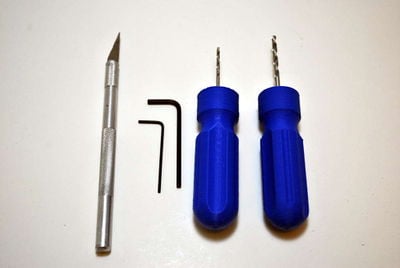(Created page with " =Affixing Magnets for Magnetic Ball Joints= NOTES: * '''Do not let the magnets slam together!''' They are very brittle and will break surprisingly easily if mishandled. They...") |
|||
| Line 2: | Line 2: | ||
=Affixing Magnets for Magnetic Ball Joints= | =Affixing Magnets for Magnetic Ball Joints= | ||
{| | |||
|- | |||
|[[File:MOST_end_effector_material.JPG|thumb|400px|alt=Magnetic end effector materials|Magnetic end effector materials. Plastic epoxy and assembled hot end not pictured.]] | |||
||[[File:MOST_end_effector_tools.JPG|thumb|400px|alt=Necessary tools|Necessary tools for magnetic end effector.]] | |||
||{{template:MOST Delta Nav}} | |||
|- | |||
|} | |||
NOTES: | NOTES: | ||
* '''Do not let the magnets slam together!''' They are very brittle and will break surprisingly easily if mishandled. They are exceptionally strong and will slam together with enough force to break them. | * '''Do not let the magnets slam together!''' They are very brittle and will break surprisingly easily if mishandled. They are exceptionally strong and will slam together with enough force to break them. | ||
| Line 9: | Line 16: | ||
# Thoroughly clean the magnet mount recesses with a sharp knife. Be careful to not remove too much material as the magnets should fit snugly in them. | # Thoroughly clean the magnet mount recesses with a sharp knife. Be careful to not remove too much material as the magnets should fit snugly in them. | ||
# The magnets come in pairs with pairs being identified as those attracted to each others' same face, that is the sides with the larger diameter recesses should attract each other. Magnets should be placed in the end effector such that nearest-neighbors attract rather than repel. | |||
# Magnets are placed in their recesses with the larger diameter opening facing outward. This is the surface that mates with the ball bearing on the end of a tie rod. | # Magnets are placed in their recesses with the larger diameter opening facing outward. This is the surface that mates with the ball bearing on the end of a tie rod. | ||
# Test fit the magnets in each of their recesses - they should fit snugly and all should fit flatly against the bottom of their recess. '''Do not let the magnets slam together!''' | # Test fit the magnets in each of their recesses - they should fit snugly and all should fit flatly against the bottom of their recess. '''Do not let the magnets slam together!''' | ||
| Line 14: | Line 22: | ||
# Mix enough epoxy to coat the recesses. | # Mix enough epoxy to coat the recesses. | ||
# Coat the interiors of all the magnet recesses with a thin layer of epoxy. | # Coat the interiors of all the magnet recesses with a thin layer of epoxy. | ||
# Press the magnets into their recesses keeping in mind that the large diameter opening in the magnet points outward. | # Press the magnets into their recesses keeping in mind that the large diameter opening in the magnet points outward and the nearest neighbor magnets should attract each other. | ||
# Press the magnets all the way into the recesses using a non-magnetic tool or fingers. | # Press the magnets all the way into the recesses using a non-magnetic tool or fingers. | ||
# Wipe excess epoxy from the faces of the magnets and ensure that they are clean. After curing, excess epoxy that remains on the face of the magnets can be removed with a sharp knife. | # Wipe excess epoxy from the faces of the magnets and ensure that they are clean. After curing, excess epoxy that remains on the face of the magnets can be removed with a sharp knife. | ||
Revision as of 22:04, 30 June 2014
Affixing Magnets for Magnetic Ball Joints
 |
 |
NOTES:
- Do not let the magnets slam together! They are very brittle and will break surprisingly easily if mishandled. They are exceptionally strong and will slam together with enough force to break them.
- Do not use "steel" epoxies as many really do contain steel. They'll flow uncontrollably all over the surface of the magnet, which isn't fun to clean up.
- A non-magnetic tool for pushing the magnets into their recesses (a wooden spoon handle or aluminum x-acto knife handle works nicely).
- Do not let the magnets slam together!
- Thoroughly clean the magnet mount recesses with a sharp knife. Be careful to not remove too much material as the magnets should fit snugly in them.
- The magnets come in pairs with pairs being identified as those attracted to each others' same face, that is the sides with the larger diameter recesses should attract each other. Magnets should be placed in the end effector such that nearest-neighbors attract rather than repel.
- Magnets are placed in their recesses with the larger diameter opening facing outward. This is the surface that mates with the ball bearing on the end of a tie rod.
- Test fit the magnets in each of their recesses - they should fit snugly and all should fit flatly against the bottom of their recess. Do not let the magnets slam together!
- After ensuring the magnets fit properly in their recesses, remove them all (a small screwdriver can be inserted in their interior and then used to pry them out).
- Mix enough epoxy to coat the recesses.
- Coat the interiors of all the magnet recesses with a thin layer of epoxy.
- Press the magnets into their recesses keeping in mind that the large diameter opening in the magnet points outward and the nearest neighbor magnets should attract each other.
- Press the magnets all the way into the recesses using a non-magnetic tool or fingers.
- Wipe excess epoxy from the faces of the magnets and ensure that they are clean. After curing, excess epoxy that remains on the face of the magnets can be removed with a sharp knife.